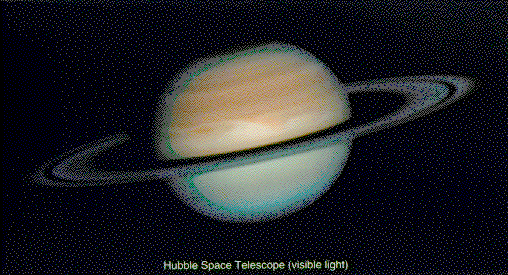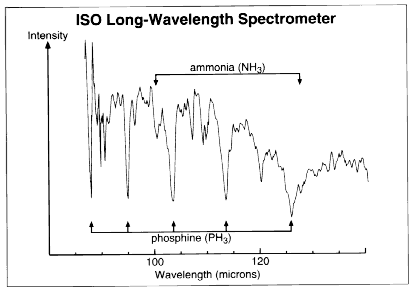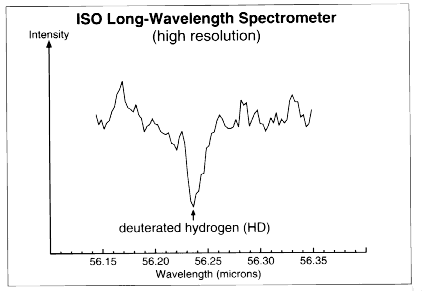Planet Saturn Long-wavelength spectra



Credits: ESA/ISO and LWS Consortium (spectra); NASA/ESA and J.T. Trauger, JPL (Hubble image).
TELLTALE MOLECULES IN SATURN'S ATMOSPHERE
Detection of constituents of Saturn, by their infrared signatures at long wavelengths, promises fresh insight into the weather and history of the giant planet. The European Space Agency's new Infrared Space Observatory, ISO, identifies molecules by their absorption of radiation at characteristic wavelengths. ISO's Long-Wavelength Spectrometer measures the intensities of emissions from 45 to 180 microns. At these infrared wavelengths the Earth's atmosphere makes cosmic observations very difficult -- hence the need for Europe's space telescope dedicated to infrared astronomy.
An image from the Hubble Space Telescope shows Saturn lit by sunlight. ISO sees the planet by its own thermal emissions, which are stronger than the scattered sunlight.
One extract from the results with the Long-Wavelength Spectrometer shows clear molecular signatures of ammonia (NH3) and phosphine (PH3), which were previously observed only with difficulty. Atmospheric scientists will be able make new deductions about the distribution of such materials at different depths, and about the weather and cloud formations on Saturn.
Working in a high-resolution mode, the Long-Wavelength Spectrometer has detected deuterated hydrogen molecules (HD) in Saturn. These contain one atom of ordinary hydrogen and one of heavy hydrogen, alias deuterium. When the Sun and its planets formed, stars had already consumed some of the deuterium available at the origin of the Universe. Planets acquired different quotas of deuterium, depending on how they were built from dust enriched in deuterium and from gas surrounding the newborn Sun. By measuring the deuterium in Saturn and other planets, astronomers expect to open a new window on cosmic history.
Note about wavelengths:
A micron is a millionth of a metre. Visible light has wavelengths 0.4 to 0.7 microns. ISO's four instruments span the infrared range from 2.4 microns up to 240 microns, or about a quarter of a millimetre.
 Return to the press release main page
Return to the press release main page
Paris, 14 February 1996
ESA Public Information & Media Offices
ESA - Paris, F, Tel. +33 1-53697111
ESTEC - Noordwijk, NL, Tel: +31 715-653006
ESOC - Darmstadt, D, Tel: +49 6151-902696
ESRIN - Frascati, I, Tel: +39 6-94180260
This Picture may be reproduced without fee, on the following conditions:
- it may not be used to state or imply the endorsement by ESA or any ESA employee of a commercial product, process or service, or used in any other manner that might mislead; if recognisable persons appear in this picture, use for commecial purposes may infringe their rights. If this picture is to be used in advertising or any commercial promotion, layout and copy should therefore be submitted to ESA beforehand for approval;
- the credit line should read: photo ESA.







 Return to the press release main page
Return to the press release main page